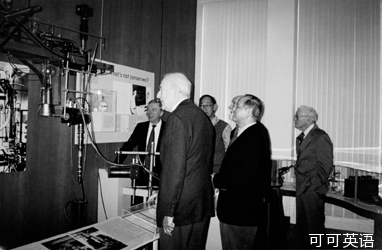
Sixty years ago, Francis Crick and James Watson announced their discovery of the structure of DNA. The academics themselves were an international pair: one was American, the other British. Back then, both needed to be in Cambridge to work together. Things had changed little in the 250 years since Isaac Newton and Gottfried Leibniz argued about calculus. Today, however, duos such as Crick and Watson can work in different countries because technology has slashed the cost of collaborating among research leaders.
60年前,弗朗西斯·克里克(Francis Crick)和詹姆斯·沃森(James Watson)宣布,他们发现了脱氧核糖核酸(DNA)的结构。这两位学者是一对国际合作伙伴:一个是英国人,另一个是美国人。当时,这种合作是建立在两人都身在剑桥大学(Cambridge University)的基础上。自艾萨克·牛顿(Isaac Newton)和戈特弗里德·莱布尼茨(Gottfried Leibniz)讨论微积分以来的250年里,这种情况基本上没有什么变化。但如今,像克里克和沃森这样的合作伙伴可身在不同的国家工作,因为科技的发展大大降低了研究带头人之间的合作成本。
The UK, and Cambridge university, provide evidence of this change. Since 1981, the number of journal articles produced by UK researchers has risen 150 per cent, to about 100,000 articles a year. But when you look at domestic papers, where all of the authors were in Britain, output is almost flat. According to the Thomson Reuters Web of Science database of 12,000 journals, since 2010 the majority of journal articles with a British-based author has had at least one co-author from another country.
英国和剑桥大学为这种改变提供了证据。1981年以来,英国研究人员发表的期刊论文数量增长了150%,达到每年10万篇左右。不过,如果你考察的是英国本土论文(即论文的作者全都住在英国),那么发表数量几乎没有变化。根据收录有1.2万份期刊的汤森路透科学网(Thomson Reuters Web of Science)数据库,自2010年以来,英国作者发表的期刊论文绝大多数都至少有一位来自其他国家的共同作者。
This is not a solely UK phenomenon. Research shows the same trend in the US, Germany, France, the Netherlands and Switzerland. Academics may reside in one country, but they belong to a community that has no boundaries. Their output is international. This has particularly affected cutting-edge research teams. We can measure the importance of research by counting how many times articles are subsequently cited by other researchers. The average citation impact of UK research is well above the world average. However, an article produced by a mixture of UK-based and foreign researchers can expect to be cited more than half as many times again compared with a wholly UK research team.
并非只有英国存在这种现象。研究表明,美国、德国、法国、荷兰和瑞士也出现了同样的趋势。学者们可能住在不同的国家,但他们却属于一个无国界的团体。他们的论文是国际合作的成果。这对最前沿研究团队的影响尤为明显。我们可以通过统计论文被引用的次数来衡量研究成果的重要性。英国论文的平均引用次数远高于世界平均水平。但不出意料的是,英国研究人员与外国研究人员合作发表的论文的平均引用次数,要比英国本土论文的平均引用次数多出一半以上。
A network of elite institutions is emerging beyond national boundaries that is almost independent of their hinterlands. Cambridge’s top international partners are all leaders themselves: the Max Planck Institute, Harvard, Massachusetts Institute of Technology, Caltech, Berkeley, Toronto, Heidelberg and Tokyo.
一个由精英研究机构组成的网络正在超越国界的限制,它几乎独立于这些机构的所在国存在。剑桥的顶级国际合作伙伴们自身也都是一流研究机构:马克斯·普朗克研究所(Max Planck Institute)、哈佛大学(Harvard)、麻省理工学院(MIT)、加州理工学院(Caltech)、加州大学伯克利分校(Berkeley)、多伦多大学(University of Toronto)、海德堡大学(Heidelberg)和东京大学(The University of Tokyo)。
Indeed, more than half of Cambridge’s research is joint with global partners. Its output is already high-impact, but it gets a citation boost from collaborative work. In the UK, the disparity in impact between domestic and international research is growing. Universities with few international partners are behind.
实际上,剑桥大学一半以上的研究是与其国际伙伴合作完成的。剑桥发表的论文本已具有很大的影响力,国际合作论文进一步推高了剑桥论文的引用次数。在英国,本土论文和国际合作论文的影响力差距越来越大。没有国际合作伙伴的大学落在了后面。
Outside Europe and North America, however, the pattern is different. Since 1981, domestic research has at least trebled among the Bric nations. Growth was astronomic in China, where research by teams there has grown tenfold since 1997 and is now 30 per cent greater than the UK’s output. “Homegrown” research is also expanding rapidly in emerging research powers such as Brazil, India, South Korea and eastern Europe.
然而,在欧洲和北美以外地区,情况则有所不同。自1981年以来,金砖四国(BRIC)的本土论文数量至少增长了两倍。中国论文数量的增长可谓“天文数字”——中国研究团队的论文数量自1997年以来增长了9倍,目前的数字比英国高出30%。巴西、印度、韩国和东欧国家等新兴论文大国的“本土”论文数量也在迅速增长。
This transformation is creating a massive global research industry that is causing some big problems for national science policy makers in advanced economies. First, reading the published output of academics from these more closed academic communities will not give our researchers access to their culture, priority setting and problem solving. So the research superpowers must start expanding partnerships between their own institutions and leading ones in the emerging research nations. Stop worrying about brain drains: the west needs to start sending scientists to work in these countries.
这种转变催生出一个庞大的全球研究产业,为发达经济体的国家科学政策制定者带来了一些重大问题。首先,我们的研究人员无法通过阅读这些较为封闭的学术团体发表的论文,来了解他们的文化、优先事项制定以及问题解决机制。因此,论文超级大国必须着手扩大本国研究机构与新兴论文国家主要研究机构的合作。别再担心人才流失:西方有必要派出科学家到这些新兴国家工作。
Furthermore, it will be tougher for governments in the west to capture future returns on investment in research. Future innovation and developments are increasingly likely to have owners in several countries. It will not be possible to generate, corral and contain the innovative knowledge within one country, so governments need to be training and retaining the people who know how to use these discoveries.
此外,西方国家的政府未来将更加难以从研发投资中收获回报。未来的创新和开发越来越有可能归多个国家的研究人员所有。单独一个国家不可能创造、圈护和控制创新知识,因此,各国政府需要培养和留住那些懂得如何运用这些发现的人才。
The primary reason for investing in the research base is to support great research. What they produce pays off in unpredictable ways, often with huge social and economic benefits. In the short term, a research base that spawned both Newton and Crick produces people who can drive innovation in business. But the challenge of weaving research into economic success is no longer just about getting the best brains into labs in your own country.
投资研究基地的主要原因是要为重大研究提供支持。研究成果的影响是不可预知的,往往会带来巨大的社会和经济效益。短期而言,培养出牛顿和克里克二人的研究基地会培养出能够推动商业创新的人才。但要想把研究成果转化为经济成果,面临的挑战将不再只是把最优秀的人才招揽至本国实验室。
The writer is director of research at Thomson Reuters IP and Science
本文作者是汤森路透知识产权与科技(Thomson Reuters IP and Science)研究主管













